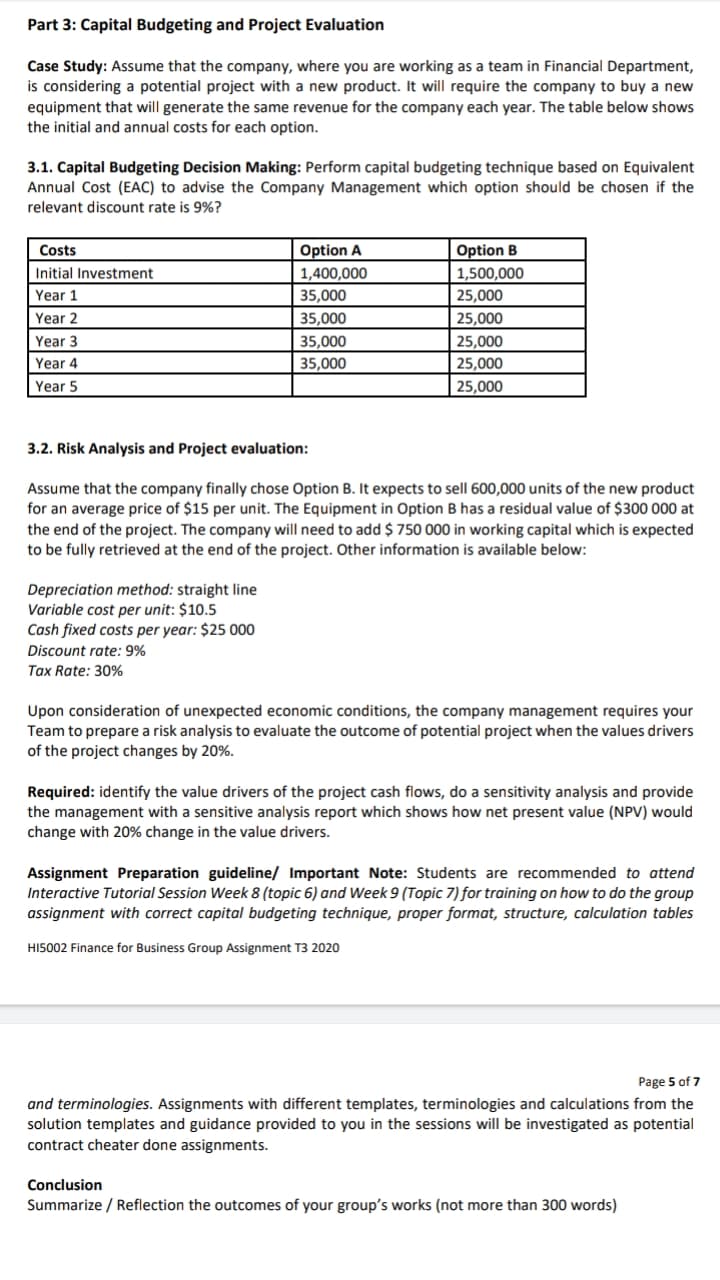3.1. Capital Budgeting Decision Making: Perform capital budgeting technique based on Equivalent Annual Cost (EAC) to advise the Company Management which option should be chosen if the relevant discount rate is 9%? Costs Option A Option B Initial Investment 1,400,000 1,500,000 25,000 25,000 Year 1 35,000 Year 2 | Year 3 Year 4 35,000 35,000 35,000 25,000 25,000 Year 5 25,000
3.1. Capital Budgeting Decision Making: Perform capital budgeting technique based on Equivalent Annual Cost (EAC) to advise the Company Management which option should be chosen if the relevant discount rate is 9%? Costs Option A Option B Initial Investment 1,400,000 1,500,000 25,000 25,000 Year 1 35,000 Year 2 | Year 3 Year 4 35,000 35,000 35,000 25,000 25,000 Year 5 25,000
Chapter17: Capital And Time
Section: Chapter Questions
Problem 17.11P
Related questions
Question
calculating capital budgeting using EAC method

Transcribed Image Text:Part 3: Capital Budgeting and Project Evaluation
Case Study: Assume that the company, where you are working as a team in Financial Department,
is considering a potential project with a new product. It will require the company to buy a new
equipment that will generate the same revenue for the company each year. The table below shows
the initial and annual costs for each option.
3.1. Capital Budgeting Decision Making: Perform capital budgeting technique based on Equivalent
Annual Cost (EAC) to advise the Company Management which option should be chosen if the
relevant discount rate is 9%?
Costs
Option A
Option B
1,500,000
25,000
Initial Investment
1,400,000
Year 1
35,000
35,000
35,000
Year 2
25,000
Year 3
25,000
Year 4
35,000
25,000
Year 5
25,000
3.2. Risk Analysis and Project evaluation:
Assume that the company finally chose Option B. It expects to sell 600,000 units of the new product
for an average price of $15 per unit. The Equipment in Option B has a residual value of $300 000 at
the end of the project. The company will need to add $ 750 000 in working capital which is expected
to be fully retrieved at the end of the project. Other information is available below:
Depreciation method: straight line
Variable cost per unit: $10.5
Cash fixed costs per year: $25 000
Discount rate: 9%
Tax Rate: 30%
Upon consideration of unexpected economic conditions, the company management requires your
Team to prepare a risk analysis to evaluate the outcome of potential project when the values drivers
of the project changes by 20%.
Required: identify the value drivers of the project cash flows, do a sensitivity analysis and provide
the management with a sensitive analysis report which shows how net present value (NPV) would
change with 20% change in the value drivers.
Assigu
Interactive Tutorial Session Week 8 (topic 6) and Week 9 (Topic 7) for training on how to do the group
assignment with correct capital budgeting technique, proper format, structure, calculation tables
Prepa
ion guideline/ Important Note: Students are recommended to attend
HI5002 Finance for Business Group Assignment T3 2020
Page 5 of 7
and terminologies. Assignments with different templates, terminologies and calculations from the
solution templates and guidance provided to you in the sessions will be investigated as potential
contract cheater done assignments.
Conclusion
Summarize / Reflection the outcomes of your group's works (not more than 300 words)
Expert Solution
This question has been solved!
Explore an expertly crafted, step-by-step solution for a thorough understanding of key concepts.
Step by step
Solved in 3 steps

Knowledge Booster
Learn more about
Need a deep-dive on the concept behind this application? Look no further. Learn more about this topic, economics and related others by exploring similar questions and additional content below.Recommended textbooks for you



